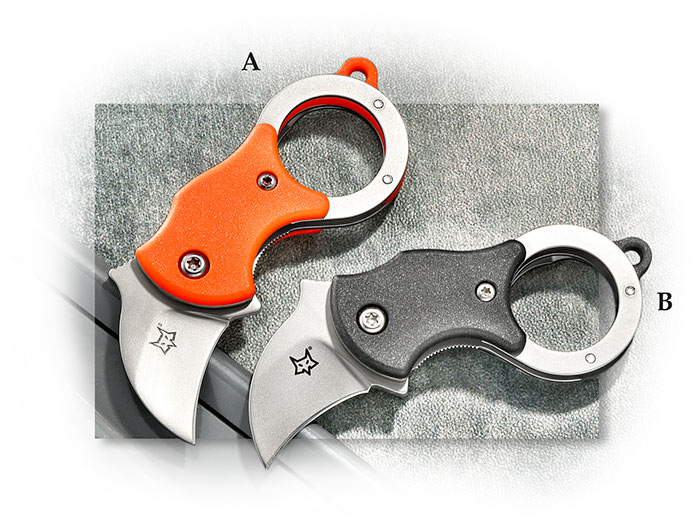Fox Mini-Ka
Item #: FO-FX535OR
$54.95
A Southeast Asian design, a Karambit typically has a curved or hooked blade designed to imitate a tiger's claw, and usually includes a safety ring at the butt. Originally designed as an agriculture tool, it quickly grew in popularity as a self-defense knife. The Mini-Ka is an adaptaton of that design. It measures only 2-3⁄8" closed with a 1.0" hawksbill style blade of bead blasted 420 stainless at 55-57 Rc. A liner lock, it can be carried either on your key ring or with the removable tip-up pocket clip. Weighs 1.2 oz. Available in either a black or orange or blue nylon handle. Made in Italy.
Option A
Fox Mini-Ka Orange
Temporarily Unavailable
Option B
Fox Mini-Ka Black
In Stock
Option
Fox Mini-Ka Blue
In Stock
Option A
Fox Mini-Ka Orange
-
TypeFolder
-
BladeHawksbill
-
Blade Length1"
-
Blade Steel420
-
Rockwell55-57
-
LockLiner-style
-
HandleNylon
-
Closed Length2-3/8"
-
ClipTip-up Removable
-
Weight1.2 oz.
-
OriginItaly
Option
Fox Mini-Ka Blue
-
TypeFolder
-
BladeHawksbill
-
Blade Length1"
-
Blade Steel420
-
Rockwell55-57
-
LockLiner-style
-
HandleNylon
-
Closed Length2-3/8"
-
ClipTip-up
-
Weight1.2 oz.
-
OriginItaly
Fox Knives
FOX Coltellerie (FOX Cutlery) has been, and remains, an important part of the knife industry in Maniago. Still family owned, the company was established in 1977 by Oreste Frati. A highly qualified staff, CNC equipment of the latest generation a strong use of the newest quality knives possible. Fox knives demonstrate that a particular attention continues to be placed on creativity and design. The knife industry in Europe, as well as Japan, has always centered around one area in each country. In England, it was Sheffield; in Germany, Solingen; in Japan, Seki City; and in Italy it has been Maniago. In the recent past, we have seen a decline in quality knife production in England, Germany, the United States and most recently in Japan. In Sheffield, the industry has been gone for a long time. There are good companies making quality knives remaining in Germany, Japan and the U.S., but they are few. Many have succumbed to the pressure to make cheaper knives which has resulted in the move of a tremendous amount of knife production first to Taiwan and then to China. It is only Maniago, the art of metal working and knifemaking has been in practice since Medieval times.


